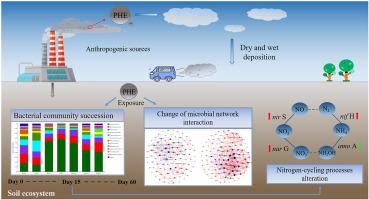Chemosphere ( IF 8.8 ) Pub Date : 2021-07-28 , DOI: 10.1016/j.chemosphere.2021.131709 Meiling Yi 1 , Lilan Zhang 1 , Cunli Qin 1 , Peili Lu 1 , Hongcheng Bai 1 , Xinkuan Han 2 , Shupei Yuan 1

|
Phenanthrene (PHE) is frequently detected in worldwide soils. But it is still not clear that how the microbial community succession happens and the nitrogen-cycling processes alter during PHE degradation. In this study, the temporal changes of soil microbial community composition and nitrogen-cycling processes during the biodegradation of PHE (12 μg g−1) were explored. The results showed that the biodegradation of PHE followed the second-order kinetics with a half-life of 7 days. QPCR results demonstrated that the bacteria numbers increased by 67.1%–194.7% with PHE degradation, whereas, no significant change was observed in fungi numbers. Thus, high-throughput sequencing based on 16 S rRNA was conducted and showed that the abundances of Methylotenera, Comamonadaceae, and Nocardioides involved in PHE degradation and denitrification were significantly increased, while those of nitrogen-metabolism-related genera such as Nitrososphaeraceae, Nitrospira, Gemmatimonadacea were decreased in PHE-treated soil. Co-occurrence network analysis suggested that more complex interrelations were constructed, and Proteobacteria instead of Acidobacteriota formed intimate associations with other microbes in responding to PHE exposure. Additionally, the abundances of nifH and narG were significantly up-regulated in PHE-treated soil, while that of amoA especially AOAamoA was down-regulated. Finally, correlation analysis found several potential microbes (Methylotenera, Comamonadaceae, and Agromyces) that could couple PHE degradation and nitrogen transformation. This study confirmed that PHE could alter microbial community structure, change the native bacterial network, and disturb nitrogen-cycling processes.
中文翻译:

菲有氧降解过程中微生物群落结构和氮循环过程的时间变化
菲 (PHE) 在全球土壤中经常被检测到。但目前尚不清楚微生物群落演替是如何发生的,以及在 PHE 降解过程中氮循环过程是如何改变的。在这项研究中,探讨了 PHE (12 μg g -1 )生物降解过程中土壤微生物群落组成和氮循环过程的时间变化。结果表明,PHE的生物降解遵循二级动力学,半衰期为7天。QPCR结果表明,随着PHE降解,细菌数量增加了67.1%~194.7%,而真菌数量没有显着变化。因此,高通量基于16s的rRNA基因测序进行,并表明的丰度Methylotenera,Comamonadaceae和类诺卡氏参与PHE降解和反硝化作用被显著增加,而那些氮代谢相关的属如Nitrososphaeraceae,硝化螺,Gemmatimonadacea在PHE处理的土壤中降低。共生网络分析表明,构建了更复杂的相互关系,变形杆菌而不是酸杆菌与其他微生物形成了对 PHE 暴露的反应的密切关联。此外,在PHE处理的土壤中,nif H和nar G的丰度显着上调,而amo A的丰度,尤其是AOA amoA被下调。最后,相关性分析,发现一些潜在的微生物(Methylotenera,Comamonadaceae和Agromyces)可能对夫妇PHE降解和氮转化。该研究证实,PHE 可以改变微生物群落结构,改变天然细菌网络,并扰乱氮循环过程。


























 京公网安备 11010802027423号
京公网安备 11010802027423号